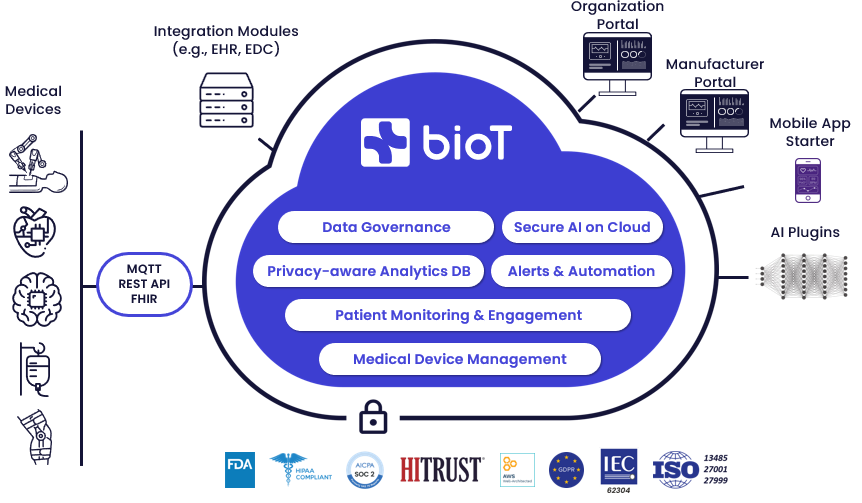Overview

An enterprise-grade system, BioT PaaS is built on the following 3 pillars: Connect, Collaborate, and Care.
Connect
Securely connect devices to the cloud in order to bring the power of cloud to device manufacturers.
-
Secure data transfer and storage, optimized per data type (numeric biomarkers, waveforms, images, raw data files, and more).
-
Cloudify - Go beyond device power and implement advanced data-driven AI algorithms on the cloud.
-
Remote device management – Configuration, status, alerts.
-
Constant updates – Seamless update of capabilities.
- Centralized, zero-touch firmware updates.
- Cloud software updates - Update once, affecting all deployments at zero time.
-
Open platform - Gain access to the collected big data to improve service for caregivers, expedite clinical trial analysis, gain visibility into Post-Market Clinical Follow-up (PMCF) studies, and correctly identify possible risks and real-world behavior in a timely manner.
Collaborate
-
Share information with doctors, patients and the ecosystem (subject to configurable fine-grained attribute-based access control policies).
-
Improve patient engagement and gain better data for your clinical trial and PMCF by personalizing the patient experience:
- Engage when the patient is most likely to cooperate and when the data is still fresh (for example, sending a questionnaire after you’ve detected a medical event).
- Send notifications via the medium convenient to your patient.
- Tailor questionnaires based on experience with the individual patient, and improve feedback.
-
Integrate with the ecosystem (EHR, RPM, EDC, QMS, etc.), share and receive information to improve your data, as well as improving clinician experience by integrating into their existing workflows.
-
Analyze adherence patterns, per patient group, across your entire deployment, to gain a better understanding of how best to get patients to use the device or follow exercise protocols.
Care
Improve patient outcome by:
-
Understanding adherence patterns and creating personal engagement in order to effectively prevent non-adherence.
-
Identifying critical events and creating automatic actions (alert physician, patients, etc.).
-
Providing real-world, accurate information for physicians, allowing better treatment decisions to be made by strong visualization modules. It combines observations with clinical events helping to develop intuition for cause and effect.
-
Providing self-management tools to patients allowing them to become an active factor in their own treatment.
- Visualization of the patient's current status and adherence, allowing the patient to understand how they are affecting the outcome.
- Self-reporting of feedback on their condition and treatment.
- Adherence management tools allow the patient to take an active part in managing their adherence, by setting targets and keeping up with them.
Updated 3 months ago
